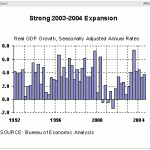
Today’s news that U.S. economic growth may not exceed 2% this year had an immediate effect on the stock market. But how long does it take a nation to recover its GDP in a slow growth period?
The U.S. economy grew at a less-than-forecast 2.8% in the fourth quarter 2011. For the full year 2011, the economy expanded 1.7% and consumer spending grew 2.2%, according to U.S. Commerce Department data. At the same time, the personal savings rate fell to 3.5% in November 2011 from 5.8% in June 2010, the Department said. To fuel personal spending, consumers used their savings.
While these numbers are for the entire U.S. economy, but how do they impact individual spending, or per capita income?
At these GDP growth rates–in the area of 1.7% for the U.S.–it will take about 60 years to double the per capita income of U.S. consumers, according to economist Ha-Joon Chang.
Writing in his book, “23 Things They Don’t Teach You About Capitalism,” Change found that per capita income doubles every 19 years when the economy is growing at 7% per year ( an astounding rate currently found in China). If the economy grows at 3.5% per year per capita, it takes about 20 years to double per capita income. But in economies growing at 1% per capita per year, it takes 70 years for a nation to double its per capita income.
(Per capita income is the income per person in a nation. It is often used to measure a country’s standard of living. GDP per capita is calculated by dividing the GDP by the population.)
Historical Perspective on Per Capita Incomes
During the Industrial Revolution (beginning in the late-1800s), the per capital incomes of people living in Western Europe, the U.S., Australia and New Zealand, grew between 1% to 1.5% (depending on the time period and nation.) During an accelerated period of economic expansion, from 1950s to the mid-1970s, per capita incomes grew at about 6% to 7% per year in East Asian nations, and China.
What’s so important about per capita income?
Per capita income is the money used by consumers to power the economy. It represents more spending and savings power. The problem is that declines in per capita income, accompanied by the vast wealth destruction Americans have seen in their home equity and portfolios, and wage stagnation, sap the spending power of American consumers.
This wealth destruction has been accompanied by more bad news on the wage front. According to the Economic Policy Institute, the average hourly wages for U.S. workers (expressed in 2007 dollars and adjusted for inflation) rose from $18.90 in 1973 to $21.34 in 2006; a 13% increase in 33 years. This equates to a 0.4% growth rate annually. When the same measure is applied to wages and benefits, the rate is even lower.
Since wages often fall during recessions (due to lay-offs and curtailed hours), they are often accompanied by employers who stop making contributions to 401(k) plans. As a result, benefits and wages fall even further. This helps explain why median worker compensation increased at a rate of 0.2% annually from 1983 to 1989, and at a rate of 0.1% per year from 1992 to 2000. There was 0% (that is zero percent) growth in wages from 2002 to 2007, based on data from the Economic Policy Institute.
This was also the same period when consumers began to tap into their home equities to supplement their declining wages. This proved to be a large factor in the collapse of the housing bubble and the sharp increase in home equity refinancing. People simply needed the money, from whatever source, to sustain their standards of living.
Without that intense flurry of desperate borrowing, we would have the current situation where millions face the prospect of a declining quality of life. But that was a bet. Today, one-quarter of U.S. homes are worth less than their mortgages, which will prove to be a drag on the economy for years.
These limited sources of new income obviously have a severe impact on the larger economy.

Harvard University economist Martin Feldstein said the growth in household spending in 2011 was largely due to consumers drawing down their savings. This cannot be repeated again in 2012, because the savings have not been replenished, he said.
“The thing that made that increase in consumer spending possible was people cut their savings rate” he said. “It’s hard to believe it’s going to happen again” at the same pace, Feldstein said.
This concern was repeated by the Economic Policy Institute which wrote that:
“Perhaps most worrisome in this report, disposable personal income rose at only a 0.8 percent rate after adjusting for inflation. What this means is that even the small growth in consumption spending in the quarter (which increased at a 2 percent rate) was partially financed by a reduction in the personal savings rate, which fell to 3.7 percent of disposable personal income—the fifth straight quarter of decline and the lowest savings rate since the last quarter of 2007.” (Posted Jan. 27, 2012)
This leaves open the question about what can propel the economy to a 2% GDP growth rate or more in 2012. From the perspective of many economists, including Feldstein, the Federal Reserve is running out of tools to accelerate the growth rate.










